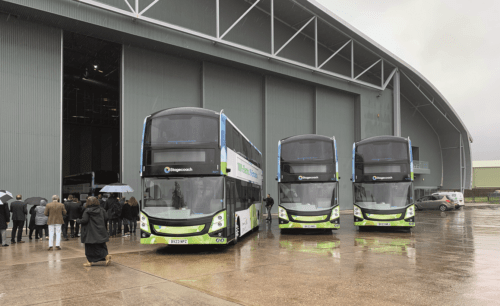
There seems to be no shortage of news stories these days which publicise the launch of an electric bus service or electric vehicle design. However, the introduction by Stagecoach of new electric double-deckers in Cambridge was different, not least because of the scale of the launch and also the manufacturers involved, with a new vehicle design. Martin Curtis was in attendance at the launch event
This launch, organised by Stagecoach and Volvo, showcased the introduction of an initial batch of 30 new 100% electric, zero-emission Volvo BZL double deckers, with more to follow, and occurred on 12 May at the Trumpington park & ride site in Cambridge.
In a cordoned-off area, several of the new buses were assembled where they could be inspected by invited guests and dignitaries together with press and TV crews. However, the existing park & ride service was attracting long queues of waiting passengers on the opposite side of the site and many gazed across asking what the new buses were about and the purpose of their presence. The nearsides of the vehicles carry legends extolling their zero-emission credentials so it was apparent something significant was about to become part of the services on which these passengers travelled. By the time they viewed social media later that day or local TV evening news, they would know the answer.
After gathering the considerable number of invited guests and officials, the buses transported everyone to the Imperial War Museum at Duxford, the former RAF airfield which now houses a large aviation collection, and familiar to so many in the bus business as the location for many years of Showbus. The journey demonstrated the smooth and quiet running of the buses with performance easily matching that of a conventional diesel bus.
[…]By subscribing you will benefit from:
- Operator & Supplier Profiles
- Face-to-Face Interviews
- Lastest News
- Test Drives and Reviews
- Legal Updates
- Route Focus
- Industry Insider Opinions
- Passenger Perspective
- Vehicle Launches
- and much more!


